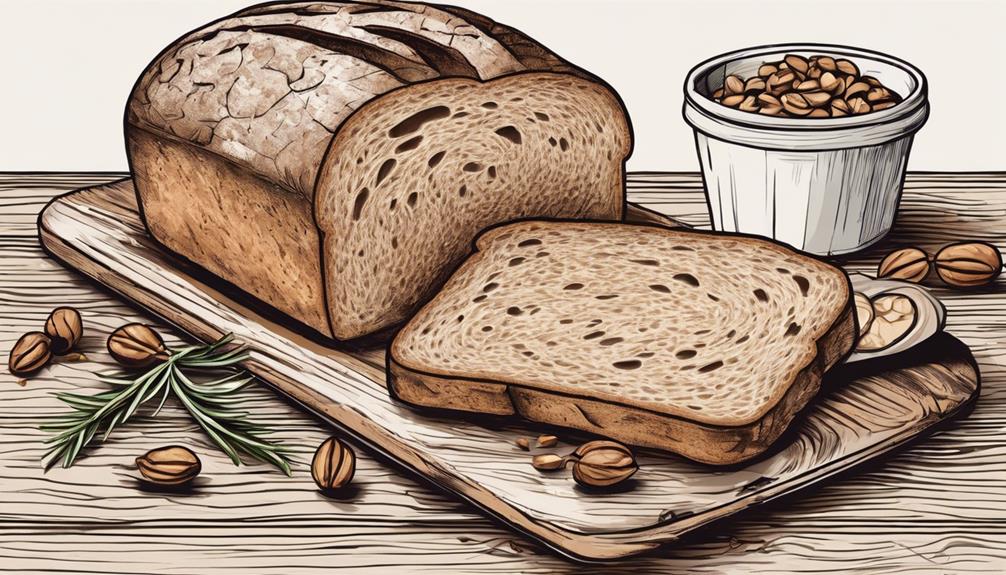Is Whole Grain Bread Good for Gout
Yes, whole grain bread is good for gout. It has lower purine content compared to white bread, which helps reduce uric acid levels. Whole grain bread is also rich in fibre, vitamins, and minerals that support overall health and help manage inflammation.
The high fibre content can stabilize blood sugar levels and promote weight control, both important for gout management. Be cautious with bread additives and preservatives, as they might trigger gout flare-ups. Including whole grains in your diet can be an effective way to manage gout symptoms and improve overall health.
Discover more about how simple dietary changes can make a big difference.
Key Takeaways
- Whole grain bread is low in purines, reducing the risk of gout flare-ups.
- The fibre in whole-grain bread helps stabilize blood sugar and control inflammation.
- Whole-grain bread supports weight management, important for reducing gout symptoms.
- Natural ingredients in whole grain bread minimize additives that could trigger gout.
- Whole grain bread is a nutritious component of a balanced diet for gout sufferers.
Understanding Gout
Gout is a type of arthritis characterized by sudden, severe attacks of pain, redness, and swelling in the joints, often caused by elevated levels of uric acid in the blood. When your body has too much uric acid, it can form sharp crystals in the joints, leading to excruciating joint pain.
Understanding gout involves recognizing its triggers, such as high purine levels found in certain foods and drinks. Purines are naturally occurring substances that, when broken down, produce uric acid.
To effectively manage gout, controlling inflammation is essential. Inflammation control can be achieved through dietary choices that help regulate uric acid levels. Avoiding foods high in purines, like red meat and certain seafood, can reduce the risk of gout flare-ups. Additionally, focusing on a balanced diet rich in low-purine foods can help manage symptoms.
Being aware of gout triggers is vital. Alcohol, sugary beverages, and stress can exacerbate the condition. By keeping these factors in check and opting for nutrient-dense foods, you can better manage your gout symptoms and reduce the frequency of painful attacks.
This understanding forms the foundation for making informed dietary choices, such as opting for whole grains over refined grains.
Whole Grains Vs. White Bread
Choosing between whole-grain bread and white bread can greatly impact your ability to manage gout symptoms effectively. Whole-grain bread offers superior nutrients compared to white bread. It’s rich in B vitamins, iron, and antioxidants, all essential for reducing inflammation risks associated with gout. Additionally, whole grain bread boasts higher fibre benefits, which help regulate digestion and promote weight management—key factors in managing gout.
White bread, on the other hand, is made from refined grains that lack many of these essential nutrients. The lower fibre content in white bread doesn’t provide the same satiety, potentially leading to overeating and weight gain, both of which can exacerbate gout symptoms. Furthermore, the glycemic impact of white bread is higher, causing rapid spikes in blood sugar levels that can trigger inflammation, a significant concern for gout sufferers.
Dietary recommendations strongly suggest opting for whole-grain bread over white bread to support your gout management. By choosing whole grains, you’re not only improving your nutrient intake but also taking a proactive step in reducing inflammation and managing your weight more effectively. This simple switch can have a meaningful impact on your overall health and well-being.
Fiber and Blood Sugar
Whole grain bread’s significant fibre content plays an essential role in regulating blood sugar levels and supporting overall health. When you choose whole-grain bread, you’re opting for a food that can stabilize your blood glucose. This stabilization helps prevent spikes and crashes in energy levels, making it easier to maintain steady energy throughout the day.
The fiber in whole-grain bread also promotes gut health, aiding in digestion and ensuring that nutrients are absorbed efficiently. Better nutrient absorption means your body can utilize vitamins and minerals more effectively, contributing to overall well-being.
Moreover, whole-grain bread can help with inflammation control, an important factor for individuals with gout. High fibre diets have been shown to reduce markers of inflammation in the body, potentially easing gout symptoms. By prioritizing whole grains, you’re not only managing blood sugar but also supporting your body’s natural anti-inflammatory processes.
Incorporating whole-grain bread into your diet is a proactive step towards maintaining balanced blood glucose levels, improving gut health, and enhancing nutrient absorption. These benefits collectively support better energy management and inflammation control, essential for those living with gout.
Weight Management Benefits
Incorporating whole-grain bread into your diet can greatly help in weight management, an important step for reducing the risk of gout. This type of bread is packed with nutritional value, providing essential vitamins, minerals, and antioxidants that support your overall health.
One of the key benefits of whole grain bread is its high fibre content, which plays a critical role in weight control by promoting satiety. When you feel fuller for longer periods, you’re less likely to overeat, aiding in weight management.
Additionally, the fibre in whole-grain bread contributes to better digestive health. A healthy digestive system is essential for maintaining a balanced weight, as it ensures proper nutrient absorption and regular bowel movements.
Whole grain bread’s lower glycemic index also helps stabilize blood sugar levels, which can prevent cravings and reduce the risk of weight gain.
Additives and Preservatives
While whole grain bread’s benefits for weight management are significant, it’s also important to scrutinize the additives and preservatives in your bread choices to prevent potential gout flare-ups. Preservative dangers and additive concerns are real when it comes to managing gout. Certain preservatives and additives can potentially increase purine levels, which are known gout triggers.
To confirm your whole grain bread is as gout-friendly as possible, you should engage in thorough ingredient scrutiny. Look for bread that lists natural ingredients and avoid those with a long list of chemical additives. Common preservatives like BHA and BHT, as well as artificial flavourings and colourings, can sometimes contribute to inflammation and other reactions that exacerbate gout symptoms.
Choosing whole-grain bread with minimal additives and preservatives can help you manage your condition more effectively. Always read labels carefully to make sure there are no hidden high-purine additives. Opt for brands that prioritize natural ingredients and minimal processing, as these choices are less likely to trigger a gout flare-up. By being vigilant about what goes into your bread, you can enjoy the benefits of whole grains while minimizing the risk of gout complications.
Foods to Avoid
When managing gout, it’s essential to avoid high-purine foods such as red meat, organ meats, and certain seafood. These foods have a high purine content, which can elevate uric acid levels in your body. Elevated uric acid often leads to crystal formation in the joints, resulting in severe joint pain and inflammation.
Certain seafood like anchovies, sardines, and mackerel also have high purine levels, which can trigger gout flare-ups. Processed meats, including sausages and deli meats, should be minimized due to their potential to exacerbate inflammatory responses and increase uric acid levels.
It’s equally important to limit alcohol consumption, particularly beer and spirits, as they can raise uric acid levels and contribute to joint pain. Sugary drinks and foods high in fructose, like sodas and certain fruit juices, can also lead to higher uric acid levels and should be avoided.
Gout-Friendly Foods
After identifying foods to avoid, it’s equally important to focus on gout-friendly options that can help manage your condition effectively. Incorporating foods that are low in purines and rich in nutrients can greatly reduce gout triggers.
Whole grain bread, for instance, offers tremendous nutritional benefits, including high fiber content which aids in blood sugar regulation and weight management.
When it comes to meal planning, aim to include a variety of fruits, vegetables, and lean proteins. Foods like cherries, berries, and leafy greens are anti-inflammatory and can help lower uric acid levels. Opt for lean proteins such as chicken and fish, but be mindful of portion sizes to avoid excessive purine intake.
Healthy recipes that emphasize whole grains, like quinoa salads or whole grain pasta dishes, can be both delicious and beneficial for your gout management. Incorporating these recipes into your diet can make meal planning easier and more enjoyable.
Lastly, consider lifestyle changes such as increasing water intake and reducing alcohol consumption. Staying hydrated helps flush out uric acid while limiting alcohol can prevent gout flare-ups.
Frequently Asked Questions
Conclusion
By choosing whole-grain bread over white bread, you’re making a smart move for managing gout. The higher fibre content helps control blood sugar and supports weight management, both essential for gout prevention.
Additionally, whole-grain bread contains fewer additives and preservatives, reducing the risk of worsening symptoms. Integrating whole-grain bread into your diet can be a pivotal step towards alleviating gout flares and enhancing your overall health.
Disclaimer: This article is intended for educational and informational purposes only. It should not be considered as professional medical advice, diagnosis, or treatment. Always consult with a qualified healthcare provider, such as a rheumatologist or physician, before making any changes to your diet or treatment plan for managing gout or any other medical condition. The information presented in this article is general and may not be suitable for all individuals. Seek personalized guidance from a medical professional to ensure appropriate care based on your specific circumstances and health status.







